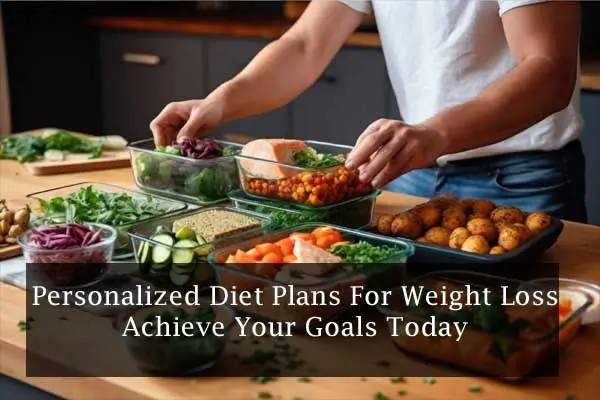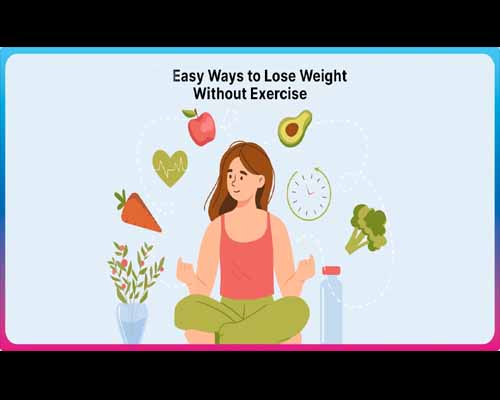In today’s fast-paced world, achieving weight loss goals often feels overwhelming. The internet is filled with countless fad diets and quick-fix solutions, confusing and frustrating many people. However, the key to sustainable weight loss is adopting a personalized diet meal plan for weight loss that aligns with your unique needs, lifestyle, and preferences. Coupled with practical exercise routines, a customized diet plan can make you healthier and happier.
This article provides a step-by-step guide to creating personalized diet plans for weight loss, discusses the benefits of a customized diet plan for weight loss free, and offers a free weight loss plan for beginners, complemented by practical exercise recommendations.
Why Choose a Personalized Diet Plan?
A personalized diet plan is tailored to meet your nutritional needs, weight loss goals, and lifestyle preferences. Unlike generic meal plans, these diets consider factors like your:
- Current weight and body composition
- Age and gender
- Activity level
- Food preferences or dietary restrictions
- Health conditions or allergies
By addressing these variables, a personalized diet plan ensures long-term success by providing sustainable, enjoyable, and effective eating habits.
How to Create a Personalized Diet Meal Plan for Weight Loss
Step 1: Determine Your Caloric Needs
Weight loss begins with a caloric deficit—consuming fewer calories than your body burns. Here’s how to estimate your daily caloric needs:
- Calculate your Basal Metabolic Rate (BMR) using a BMR calculator.
- Multiply your BMR by your activity level to determine your Total Daily Energy Expenditure (TDEE).
- Subtract 500–750 calories from your TDEE for safe weight loss (1–2 pounds per week).
Example:
- BMR: 1500 calories
- TDEE: 2000 calories
- Caloric target for weight loss: 1250–1500 calories/day
Step 2: Distribute Your Macronutrients
A balanced diet includes the right proportion of carbohydrates, proteins, and fats:
- Protein (25–30% of total calories): Essential for muscle repair and satiety.
- Carbohydrates (40–50% of total calories): Provide energy and should primarily come from whole grains and vegetables.
- Healthy Fats (20–25% of total calories): Necessary for hormonal balance and nutrient absorption.
Step 3: Plan Your Meals
A personalized diet meal plan for weight loss should consist of:
- Breakfast: High-protein foods like eggs, Greek yogurt, or oatmeal.
- Lunch: Lean proteins, whole grains, and fiber-rich vegetables.
- Dinner: Light meals with lean proteins and steamed or sautéed vegetables.
- Snacks: Healthy options like nuts, seeds, or fruit.
Step 4: Hydration and Timing
- Hydrate: Drink at least 8–10 glasses of water daily to aid digestion and metabolism.
- Meal Timing: Space meals evenly throughout the day to maintain energy levels and prevent overeating.
Customized Diet Plan for Weight Loss Free
Here’s a free weight loss plan for beginners designed to kickstart your journey:
Day 1 Sample Plan
Breakfast:
- 1 boiled egg or vegetable omelet
- 1 slice of whole wheat bread
- 1 cup of green tea
Snack:
- 1 medium apple or a handful of roasted chickpeas
Lunch:
- Grilled chicken breast (100g)
- 1 small whole wheat roti or ½ cup of brown rice
- Steamed vegetables (e.g., broccoli, carrots, or zucchini)
Snack:
- 10 almonds or a small serving of yogurt
Dinner:
- Grilled fish or lentil soup
- Mixed green salad with olive oil dressing
Beverage:
- Chamomile tea before bed
Day 2 Sample Plan
Breakfast:
- A smoothie made with low-fat milk, banana, and spinach
- 1 tablespoon of peanut butter
Snack:
- 1 orange or guava
Lunch:
- Grilled paneer or tofu
- ½ cup of quinoa or boiled sweet potatoes
- Cucumber and tomato salad
Snack:
- 1 boiled egg or a handful of walnuts
Dinner:
- Chicken or vegetable stir-fry
- 1 small whole wheat bread
Beverage:
- Mint-infused water
Step-by-Step Exercise Guide for Beginners
Physical activity is crucial for weight loss as it accelerates fat burning and boosts metabolism. Here’s a step-by-step exercise guide for beginners:
Step 1: Warm-Up (5–10 Minutes)
Start with a light warm-up to prepare your body for exercise:
- Jumping jacks: 1 minute
- High knees: 1 minute
- Arm circles: 1 minute
Step 2: Cardio (20–30 Minutes)
Engage in cardiovascular exercises to burn calories:
- Brisk walking: 30 minutes (outdoor or on a treadmill)
- Cycling: 20 minutes
- Jump rope: 10 minutes
Step 3: Strength Training (10–15 Minutes)
Build lean muscle with these beginner-friendly exercises:
- Bodyweight Squats – 3 sets of 10 repetitions
- Push-Ups – 2 sets of 8–10 repetitions
- Plank Hold – 2 sets of 20–30 seconds
Step 4: Cool Down (5–10 Minutes)
Stretching helps prevent soreness and improves flexibility:
- Hamstring stretch: 30 seconds each side
- Shoulder stretch: 20 seconds each side
- Child’s pose: 30 seconds
Benefits of Combining a Personalized Diet with Exercise
- Accelerated Fat Loss: Exercise increases calorie burn, complementing the caloric deficit from your diet.
- Improved Muscle Tone: Strength training shapes and firms your body.
- Better Metabolism: Regular activity boosts your resting metabolic rate.
- Enhanced Mood: Physical activity releases endorphins, reducing stress and improving mental well-being.
- Long-Term Sustainability: Combining healthy eating with exercise promotes lasting lifestyle changes.
Common Mistakes to Avoid
- Skipping Meals: Leads to overeating later and slows metabolism.
- Overly Restrictive Diets: Unsustainable and often lead to nutrient deficiencies.
- Ignoring Exercise: Weight loss is best achieved with a combination of diet and activity.
- Lack of Hydration: Dehydration can hinder metabolism and cause fatigue.
- Unrealistic Goals: Aim for gradual weight loss (1–2 pounds per week).
Diet Plan for 65kg Individuals
Target Caloric Intake: 1500–1600 calories/day
Step 1: Breakfast
- 2 boiled eggs or scrambled egg whites
- 1 slice of whole-grain bread
- 1 cup of green tea or black coffee
Step 2: Mid-Morning Snack
- 1 medium-sized apple or orange
- 5 almonds
Step 3: Lunch
- Grilled chicken breast (100g)
- 1 small whole wheat roti or ½ cup brown rice
- Steamed vegetables (broccoli, spinach, carrots)
Step 4: Afternoon Snack
- A handful of roasted chickpeas or low-fat yogurt
Step 5: Dinner
- Baked fish or lentil soup
- Mixed salad with olive oil and lemon dressing
Step 6: Hydration
- Drink 2–2.5 liters of water daily.
Diet Plan for 70kg Individuals
Target Caloric Intake: 1600–1700 calories/day
Step 1: Breakfast
- Oatmeal cooked in skim milk, topped with a few blueberries
- 1 boiled egg
- 1 cup of herbal tea
Step 2: Mid-Morning Snack
- 1 small banana or pear
- 5–6 walnuts
Step 3: Lunch
- Grilled chicken or turkey (120g)
- ½ cup of quinoa
- Steamed zucchini and green beans
Step 4: Afternoon Snack
- 1 small handful of mixed seeds (flaxseeds, sunflower seeds)
Step 5: Dinner
- Stir-fried tofu or paneer with bell peppers
- Mixed green salad
Step 6: Hydration
- 2.5 liters of water daily
Diet Plan for 75kg Individuals
Target Caloric Intake: 1700–1800 calories/day
Step 1: Breakfast
- 2 boiled eggs and 1 slice of avocado toast
- 1 cup of black coffee
Step 2: Mid-Morning Snack
- 1 handful of roasted peanuts
- 1 small peach or guava
Step 3: Lunch
- Grilled fish (150g)
- ½ cup boiled sweet potatoes
- Steamed broccoli
Step 4: Afternoon Snack
- 1 cup of buttermilk or unsweetened yogurt
Step 5: Dinner
- Lentil curry with a small whole wheat roti
- Cucumber and tomato salad
Step 6: Hydration
- 2.5–3 liters of water daily
Diet Plan for 80kg Individuals
Target Caloric Intake: 1800–1900 calories/day
Step 1: Breakfast
- 1 boiled egg and a bowl of oatmeal with honey
- 1 cup of green tea
Step 2: Mid-Morning Snack
- 1 handful of almonds and raisins
Step 3: Lunch
- Grilled chicken or lean beef (150g)
- 1 small whole wheat roti
- Steamed spinach and carrots
Step 4: Afternoon Snack
- 1 small cup of roasted chickpeas
Step 5: Dinner
- Vegetable soup with tofu or grilled fish
- A side of sautéed green beans
Step 6: Hydration
- 3 liters of water daily
Diet Plan for 85kg Individuals
Target Caloric Intake: 1900–2000 calories/day
Step 1: Breakfast
- Scrambled egg whites with spinach and tomatoes
- 1 slice of whole-grain bread
- 1 cup of black coffee
Step 2: Mid-Morning Snack
- 1 medium-sized fruit (apple, orange)
- 1 handful of mixed nuts
Step 3: Lunch
- Grilled chicken breast (180g)
- ½ cup of brown rice or quinoa
- Steamed asparagus and zucchini
Step 4: Afternoon Snack
- 1 small serving of yogurt or roasted peanuts
Step 5: Dinner
- Grilled salmon with a side of roasted vegetables
Step 6: Hydration
- 3–3.5 liters of water daily
Diet Plan for 90kg Individuals
Target Caloric Intake: 2000–2100 calories/day
Step 1: Breakfast
- A smoothie made with spinach, banana, and almond milk
- 1 boiled egg
Step 2: Mid-Morning Snack
- 1 handful of pumpkin seeds
Step 3: Lunch
- Grilled chicken or beef steak (200g)
- 1 small whole-grain roti or ½ cup of quinoa
- Steamed vegetables (broccoli, carrots)
Step 4: Afternoon Snack
- 1 small cup of roasted chickpeas or nuts
Step 5: Dinner
- Vegetable stir-fry with tofu or paneer
- Mixed salad
Step 6: Hydration
- 3.5 liters of water daily
Diet Plan for 95kg Individuals
Target Caloric Intake: 2100–2200 calories/day
Step 1: Breakfast
- Omelet made with 2 egg whites, spinach, and onions
- 1 slice of whole-grain toast
- 1 cup of green tea
Step 2: Mid-Morning Snack
- 1 small pear or peach
- 1 handful of almonds
Step 3: Lunch
- Grilled chicken breast (200g)
- ½ cup of boiled sweet potatoes
- Steamed green beans
Step 4: Afternoon Snack
- 1 cup of low-fat yogurt
Step 5: Dinner
- Baked salmon or grilled tofu with a side of sautéed vegetables
Step 6: Hydration
- 3.5–4 liters of water daily
Diet Plan for 100kg Individuals
Target Caloric Intake: 2200–2300 calories/day
Step 1: Breakfast
- 1 bowl of oatmeal topped with chia seeds and banana slices
- 1 boiled egg
Step 2: Mid-Morning Snack
- A handful of roasted peanuts or walnuts
Step 3: Lunch
- Grilled chicken or fish (220g)
- 1 small whole wheat roti
- Steamed vegetables (e.g., zucchini, carrots, and green beans)
Step 4: Afternoon Snack
- 1 small apple and a few almonds
Step 5: Dinner
- Lentil soup or vegetable stir-fry
- Mixed salad
Step 6: Hydration
- 4 liters of water daily
Additional Tips for All Weight Ranges
- Exercise Daily: Combine cardio (walking, jogging) with strength training.
- Stay Consistent: Stick to your plan, even on weekends.
- Track Progress: Use a food diary or app to monitor your meals and weight loss journey.
- Consult a Professional: Work with a dietitian for further customization if needed.
These diet plans and regular exercise will help you achieve your weight loss goals while maintaining your health and energy levels.
Final Thoughts
A personalized diet plan for weight loss and a practical exercise routine is your key to achieving sustainable results. By focusing on balanced nutrition, portion control, and regular physical activity, you can make lasting changes to your health and well-being.
For beginners, following a customized diet plan for weight loss free and incorporating simple exercises can be a game-changer. Consistency is crucial—stick to your plan, stay motivated, and consult a healthcare provider for personalized advice.
Start your journey today with these practical steps, and watch your weight loss goals become a reality!


